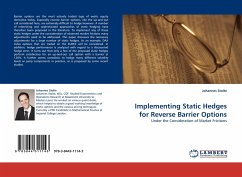Barrier options are the most actively traded type of exotic equity derivative today. Especially reverse barrier options, like the up-and-out call considered here, are extremely difficult to hedge however. A number of interesting and sophisticated approaches of static hedging have therefore been proposed in the literature. To implement any of these static hedges under the consideration of observed market frictions many adjustments need to be addressed. This paper discusses the necessary adjustments for a large number of static hedges. As an example, DAX index options that are traded on the EUREX will be considered. In addition, hedge performance is analyzed with regard to a discounted hedge error. It turns out that only a few of the proposed static hedges perform satisfactory for an up-and-out call option with a barrier at 120%. It further seems unrealistic to hedge many different volatility levels or jump components in practice, as is proposed by some recent studies.
Bitte wählen Sie Ihr Anliegen aus.
Rechnungen
Retourenschein anfordern
Bestellstatus
Storno








